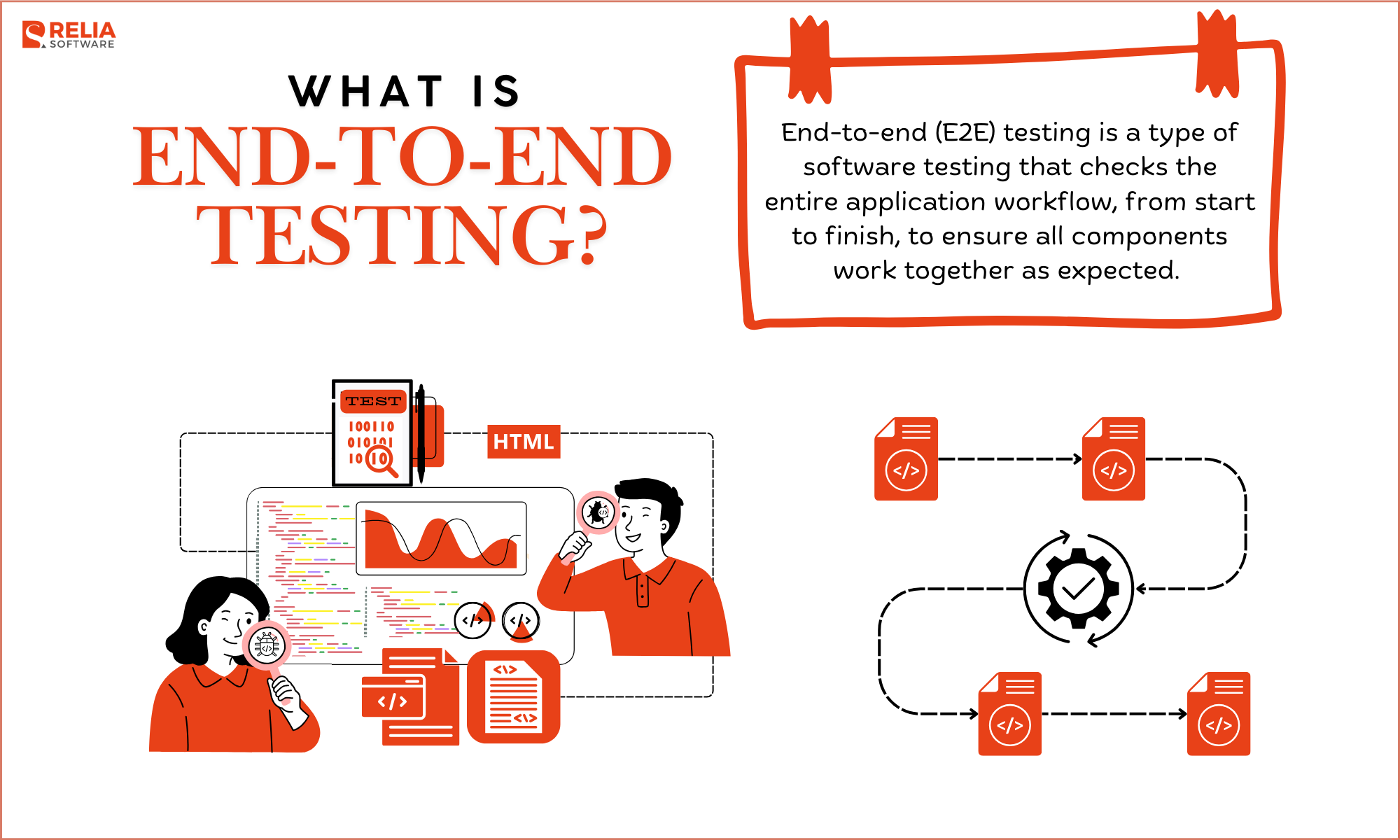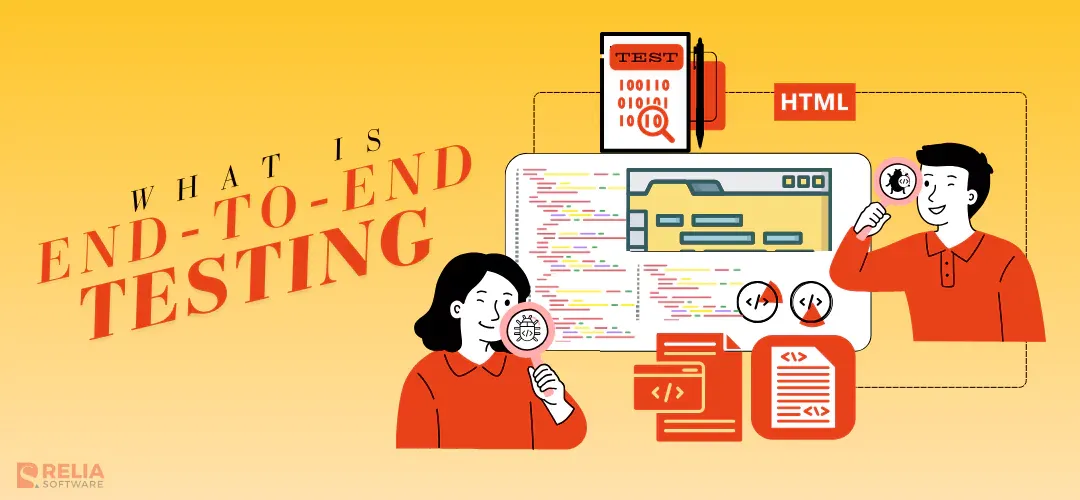User-centric is one of the important strategies in web and app development. End-to-end testing is a testing methodology requiring developers and testers to understand and get insight from the user's view.
So what is end-to-end testing? How does it work? And what are the benefits of this kind of test? Let’s discover with us in this article.
>> Read more: React Native End-To-End Testing With Detox
What is End-to-end Testing?
End-to-end (E2E) testing is a type of software testing that checks the entire application workflow, from start to finish, to ensure all components work together as expected.
By emulating real-world user scenarios and recreating live data, this testing can examine the whole software app from beginning to end of the program. Its goal is to find defects that occur when all of the parts are combined, guaranteeing that the program produces the intended result as a united entity.
End-to-end testing provides testers with a view of how the program performs from the perspective of the end user, giving them a more comprehensive grasp of the software quality prior to release.
End-to-end testing is often carried out by quality assurance (QA) teams in specific test environments. This is usually done after functional and system testing. End-to-end testing begins with the user in mind, modeling typical tasks that the application can execute.

Lifecycle of End-to-end Testing
>> You may consider:
- Software Development Life Cycle (SDLC): A Complete Guide
- Software Testing Life Cycle (STLC)
Four components of an end-to-end software testing life cycle are test planning, design, execution, and results analysis.
Test Planning
When the integration testing is finished, the test planning step begins. A test plan outlines test objectives based on the initial customer requirements and application design.
Test Design
Based on the customer requirements, a suitable testing environment is established. Typically, the test environment has already been configured for earlier test runs, and testers can use these existing configurations.
Risk and consumption analyses are also performed to more effectively assign the appropriate resources to fulfill test objectives. Following that, testers begin developing the necessary test cases, leveraging automated testing technologies to reduce time spent on test design.
Test Execution
Locally and remotely, test cases are executed to examine test progress for conformity to the original test plan.
Results Analysis
Analyzes test findings to determine the root cause of the bug. These discoveries will be forwarded to the development team for urgent action. Following that, a project retrospective is carried out to review procedures and discuss areas for improvement.

2 Types of End-to-end Testing
End-to-end testing includes two types of tests which are horizontal and vertical end-to-end test. Let’s discover these two tests below!
Horizontal End-to-end test
The most common and well-known approach is horizontal end-to-end testing. Horizontal testing determines whether a user can browse a system, whether it functions as planned, and whether there are any unexpected problems or exceptions.
When the term "end-to-end testing" is mentioned, the end user envisions horizontal end-to-end testing. Testers use this strategy to ensure that each particular workflow in the program works properly. The product search tool, web page features, product ordering stages, and shipping details will be tested.
In other words, horizontal end-to-end testing requires QA specialists to put themselves in the shoes of the user and test how they interact with every customer-facing part of the program.
Vertical End-to-End test
A more technical method is vertical end-to-end testing. Testers must guarantee that the necessary data is transferred to the right place at the right time to enable background program activity, contrasting end users, who only interact with the frontend.
Vertical end-to-end testing applies to layer testing, which occurs in a sequential, hierarchical order. Any part of a product or system is evaluated from beginning to end to ensure quality. Vertical testing is commonly used to evaluate crucial components of a complicated computer system that do not involve users or interfaces. Vertical end-to-end testing is preferable to horizontal end-to-end testing for a layer without a user interface (UI).
>> Read more:
- End-to-End Testing Tools and Frameworks: Streamline Your Testing Process
- Top 6 Automation Testing Tools for Businesses
End-to-end Testing Examples
This end-to-end testing process has a variety of uses. An example of end-to-end testing is software that serves as a flight ticketing system.
1. First, we have to enter the program link/URL, followed by logging into the operating system using proper user credentials.
2. Enter the origin and location, date of travel, travel class, and mode of transportation.
3. Choosing the selected selection and amount of tickets, and paying with the same app
4. The flow concludes with a copy of the ticket shown for the user to print. Another copy is automatically sent to their email address.
Benefits of End-to-end Testing
End-to-end testing is more reliable and commonly used due to the following advantages:
-
Quality control at various application levels: Recently apps have been built on complicated architecture with numerous layers of interrelated processes. These layers may function properly when separated, but they clash when linked. End-to-end testing can validate the interactions of these many layers and components.
-
Backend QA: End-to-end testing first validates the backend layers, particularly the application's database, which feeds essential information to other levels in order for the program to function.
-
End-to-end testing verifies the frontend: This ensures that the application functions as expected across a wide range of browsers, devices, and platforms. Cross-browser testing is commonly used for this reason.
-
Testing third-party applications: External systems are integrated into the program to execute extremely particular tasks. End-to-end testing guarantees that external and internal systems are compatible, as well as that data is communicated between them.
Drawbacks of End-to-end Testing
End-to-end testing has a number of disadvantages, some of which are listed below:
-
Poor execution
-
Tests that crumble
-
Very hard to debug
-
Poor testing conditions
End-to-end testing has drawbacks that should not be ignored. Hinder execution can hinder the integration of new features or bug fixes, build, and release times, and these issues worsen as your program grows.
Flaky end-to-end testing is also annoying. End-to-end tests often pass in one setting but fail in another. Common end-to-end testing failures include:
-
Internet speeds vary.
-
Variable computer speeds
-
Web browser timeouts
-
Request timeouts
-
Uncertain AJAX request resolution
When developing tests, it's crucial to keep these typical end-to-end testing failure causes in mind.
Why is End-to-end Testing Important for Businesses?
End-to-end testing of any kind simulates real-world scenarios, such as interactions with hardware, networks, and databases. End-to-end testing incorporates the benefits of white and black box testing.
White box testing is similar to vertical end-to-end testing in that it investigates the inner workings of a software or system. Black box testing is similar to horizontal end-to-end testing in that it focuses on functionality without investigating a program's or system's core working structures.
The purpose of mimicking real-world circumstances from the perspective of the user aids in ensuring that software programs function as intended. It maintains consistent data flow across processes, discovers system dependencies, and verifies system integrations.
>> Read more: Exploring The Importance Of Software Testing
Metrics for Successful End-to-end Testing
Among the several testing factors utilized in end-to-end testing are:
-
Test Case Preparation Status: Determines the exact position of test cases in preparation in comparison to intended test cases.
-
Tracking Test Progress: This measure records information regarding completed tests as percentages. Executed and unexecuted tests, passed or failed tests, and valid or invalid tests are all tracked in percentages.
-
Status and Details of Defects: It provides a weekly proportion of closed and open defects. Defect distributions are also depending on severity and priority on a weekly basis.
-
Environment Availability: This measure records the operational hours of test environments as scheduled testing hours per day.
How to Set Up End-to-end testing?
End-to-end testing starts with scenario design. This is followed by human testing until automation is ready. Details on the steps of setting up end-to-end settings are as follows.
Creating end-to-end tests
First, assess the testing results verification requirements. Next, establish testing environments and system and subsystem processes. For instance, a financial software login page includes:
1. Enter username and password
2. Log in or sign up as a new user.
3. Click ‘Forgot Password’ to reset your password.
Select the necessary testing tools and structure. Highlight each test case's requirements. List system output and input data before testing. These preparation activities ensure testing success.
Manual end-to-end testing
Manual user software testing is done by humans. This helps the tester assess function performance while writing test cases. Manual testing reveals hidden user interaction paths. Future test case automation will benefit from this information.
Furthermore, manual testing uses horizontal and vertical end-to-end approaches.
Horizontal end-to-end testing examines all application user pathways; software developers must construct test procedures to analyze many subsystems. You may test database, UI, and email integration simultaneously.
Also, horizontal end-to-end testing is done within a single application and across numerous applications. A web-based eCommerce system software includes accounts, shipment details, product inventory status, and more.
Vertical end-to-end testing tests the application layer by layer systematically and hierarchically. Testing crucial components of complicated systems without interfaces or users is common. Starting to completion, every product component is tested.
Bugs are easily found using this operation. Thus, they precede horizontal end-to-end testing.
Automation of end-to-end testing
Finally, large test processes with interdependent user interface operations should use automated end-to-end testing. Complex test systems save time by automating testing with Katalon Studio. A test case automation tool is used for this strategy.
This option finds flaws faster by automatically checking test code bases when new codes are added. End-to-end testing automation should be promoted due to the rapid addition of software functionalities.
>> Read more: An Ultimate Guide to Different Test Case Design Techniques
Conclusion
End-to-end testing is an essential part of developing web or applications for users. End-to-end testing lets testers see how the program works from the user's point of view. This gives them a better idea of the quality of the software before it's released.
Here comes the detailed explanation of end-to-end testing above. Hope this article gives you useful information!
>>> Follow and Contact Relia Software for more information!
- testing
- development

